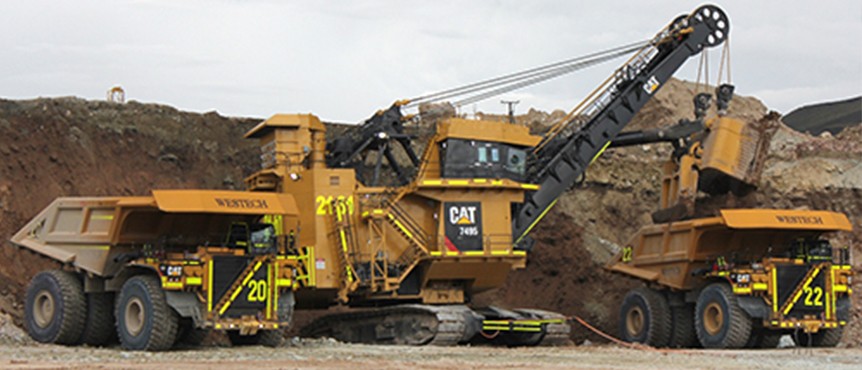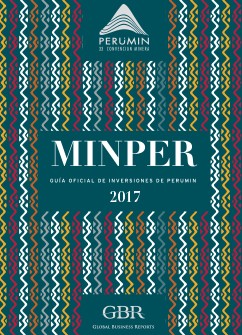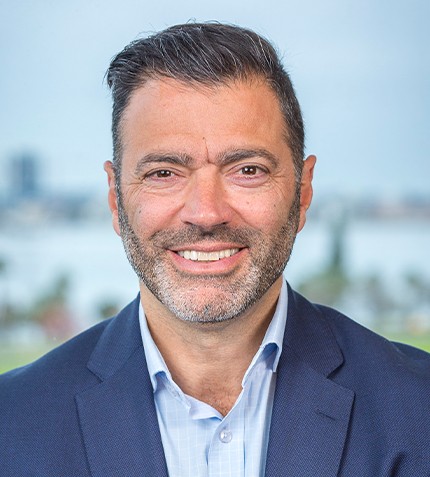Peru's copper output reached 2.35 million metric tons in 2016.
RELATED PUBLICATION
ARTICLES FROM THIS PUBLICATION
Mineral Production in Peru

Copper
It was another great year for Peru’s copper production. With the completion of Cerro Verde’s expansion, operated by Freeport McMoRan, and the start of commercial production at Las Bambas by MMG, total copper output reached 2.35 million metric tons (mt) during 2016, a 38% increase year-on-year and a 70% increase over 2014 figures. Thus Peru reinforces its position as the world’s second largest producer of the red metal after Chile, while Chinese copper output only grew by 11%, for a total of 1.85 million mt/y.
Company-wise, and according to data by the Ministry of Energy and Mines, Cerro Verde became the largest contributor with 522,100 mt/y (+104%), followed by Antamina with 443,600 mt/y (+8%), Las Bambas with 329,400 mt/y and Southern Copper with 312,900 mt/y (-3%) between the Toquepala and Cuajone operations.
Southern Copper is actually expanding Toquepala through a $1.25 billion investment to double milling capacity to 120,000 mt/d and thus add an extra 100,000 mt/y of copper production starting next year. Óscar González Rocha, president of Southern Copper, highlighted the fact that the expansion will be completed with the installation of just two large 30,000 mt/d mills. “It does sound unreal, but the existing capacity of 60,000 mt/d consists of a total of 41 mills. This is an operation that has more than 50 years.”
After this, Southern will embark on the expansion of the smelter and refinery located in Ilo. The smelter will increase its processing capacity from 1.2 million mt/y to 1.8 million mt/y, while the refinery will go from 280,000 mt/y to 320,000 mt/y of cathodes. “The remaining production will be sold as anodes from the smelter. Once we finish the Toquepala expansion, we will decide if we expand the smelter first or if we go with the two projects in parallel. In total, we are talking of an investment of $800 million to $1 billion,” said González Rocha, a figure that could become $2.6 billion if the company also goes ahead with the $500 million expansion projected at Cuajone to reach 120,000 mt/d of throughput capacity, and if the controversial Tía María project also sees the light at some point.
Southern is also reportedly interested in buying a stake in Anglo American’s Quellaveco project due to the location of this deposit in between Toquepala and Cuajone. Luis Marchese, country manager of Anglo American, admitted that the company could incorporate a partner for the project: “It is unclear at this point if we will maintain our participation or if a new partner will join in. We need to revise the capex –we hope to lower the total amount to adapt the costs to the current market. The mine will process 127,500 mt/d, and the crystal ball says we should evaluate a construction decision mid-2018. Having said this, this schedule may change depending on market conditions,” Marchese said.
Market conditions for copper are actually good, as proven by the fact that El Brocal, a versatile poly-metallic operation, is switching its focus towards copper this year, even if the mine produces arsenical copper. Gonzalo Eyzaguirre, general manager of El Brocal, gave more details: “The complex copper concentrate is not so much penalized these days, so we have launched an ambitious project to go from 7,500 mt/d to 13,000 mt/d of mining in the underground section to be completed in just nine months. The project includes the construction of the Esperanza tunnel, a tertiary crusher and improvements to the flotation process.”
Eyzaguirre said that the project encompasses $14 million in direct investment on top of $8 million in expenditures that have been moved forward in areas such as ventilation. El Brocal is a Buenaventura subsidiary, which helps generate synergies: “Perhaps the most successful [synergy] can be found in the commercial side of things, since Buenaventura now handles the sale of concentrates in a centralized manner. This gives us a better negotiating position,” Eyzaguirre concluded.
Zinc and lead
Besides copper, El Brocal is also a medium-sized producer of zinc, a metal where Peru is a prominent producer worldwide. While zinc operators took advantage of improved metal prices in the later part of last year, overall production in Peru went down by 6% to 1.34 million mt/y. This was caused primarily by a 12% decrease in Antamina’s zinc output to 261,500 mt/y, which placed Volcan, who also suffered a 4% reduction, as the country’s largest zinc producer with approximately 273,400 mt/y. Antamina, however, expects to boost zinc output this year to reach more than 340,000 mt/y. The other large zinc player in the country is Milpo, part of Votorantim of Brazil, that reported production of 258,700 mt in 2016.
In other base metals, lead production remained flat at 314,100 mt/y, tin production decreased to 18,800 mt/y (-4%), and molybdenum output grew by 28% to just under 25,800 mt/y, helped by Cerro Verde and Antamina, which trebled and doubled their production figures, respectively.
Gold
Yanacocha’s decline continued during 2016, with gold output reaching 668,200 ounces per year (oz/y) (-27%). Meanwhile, Barrick also saw production fall at the Lagunas Norte mine, from 560,000 oz/y in 2015 to 435,000 oz/y in 2016 due to the transitioning of the ore body into the sulphide section, yet margins remained extremely attractive with all-in sustaining costs of $529/oz.
Manuel Fumagalli, executive director of Barrick, underlined some of the cost-cutting initiatives to keep the operation’s profitability: “Thanks to a digitalization initiative under our ‘best-in-class’ program, we achieved efficiency improvements in our carbon-in-column (CIC) plant, and this allowed for savings of $18.6 million last year alone. On top of that, this improved the recovery from the inventory at the leach pads, generating additional income for $5 million.”
The future of Lagunas Norte lies with the sulphide potential of the deposit and the refractory ore project, although the company is looking at ways to extend the mine life while delaying the investment on an autoclave plant. According to Fumagalli, they could develop a transition project to process the inventories: “Through screening we can recover the oxides and leach them at the leach pad, while the remaining carbonaceous material, which also contains oxides, could be processed via milling and a carbon-in-leach (CIL) plant. This way we can achieve an optimal sequence for the mine-life, because we move oxide production forward and we defer the capex required for the flotation and the autoclave process to treat the sulphides.”
In spite of the decline at the country’s largest operations, Peru’s total gold production grew by 4% in 2016 for a total 4.92 million oz/y. Some of the companies that contributed to this growth were Hochschild Mining, with the production from its largest operation, the Inmaculada gold-silver mine; and Minera Poderosa, that yielded 221,000 oz/y in 2016, a 12% increase year-on-year.
Marcelo Santillana, general manager of Poderosa, summarized the company’s recent developments: “In 2016 we met our growth targets. We obtained the permit to implement technological improvements and process 800 mt/d at our Marañón plant and we began the studies to expand our Santa María plant to 1,000 mt/d. For this project we will have to acquire additional equipment including two larger mills and a 1,000 mt/d crusher, however, the largest expenditure will be the tailings dam at a cost of $10 million.”
Poderosa currently has 8 million oz of reserves, which would extend the operation’s life to nearly 40 years at current production rates, however the company plans to invest $40 million in exploration during 2017. Additionally, Poderosa is currently building a transmission line to assure the power supply for its expanded operation, which will use an additional 2 MW of capacity.
Recent highlights in terms of precious metals operations also include Tahoe Resources’ Shahuindo, which started commercial production in 2016, and the inauguration of Buenaventura’s Tambomayo mine, located in Caylloma (Arequipa) at 4,800 meters above sea level. Víctor Gobitz, CEO of Buenaventura, gave more details about the latter: “Tambomayo, developed in record time since 2009, has overcome a tremendous logistical and technical challenge and will yield 150,000 oz/y of gold and 3 million oz/y of silver. It is an underground mine that optimizes metallurgical recovery and uses filtered tailings disposal to assure the industry’s best practices,” he said.
In regards to Tahoe’s expansion project at Shahuindo from 12,000 mt/d to 36,000 mt/d, Phil Dalke, vice-president and managing director for Tahoe in Peru, said: “Through some trade-off studies we established that ore treatment can be a better return on investment, so the Shahuindo project includes many things: the crushing and agglomeration circuit for ore treatment, a major leach pad construction, additional power and water and additional metallurgical tests to prove everything up.”
At today’s prices, Shahuindo has a mine life until 2026, and this operation will eventually replace the ounces from La Arena, the other Peruvian gold mine of the corporation. La Arena, however, is not over yet. It will continue producing 150,000 oz/y into 2020 and there are plans for a large sulphide development. Tahoe’s vice president for exploration, Brian Brodsky, provided the latest about this project: “In 2014, Rio Alto completed a feasibility study for a small operation, which included a resource of 275 million mt of mainly copper with gold credits. In 2015, we drilled some holes to prove that this body is open at depth and we have recently completed a scoping study that suggests a significantly larger project. We are currently undertaking a more detailed pre-feasibility study which should be completed later this year.”
Silver
In parallel to gold’s good performance, Peru’s silver production also increased last year by nearly 7%, reaching 140.6 million oz/y, with Buenaventura (24.7 million oz/y) Volcan (22 million oz/y) Antamina (20.9 million oz/y) and Hochschild (13.9 million oz/y) as the main producers.
Ignacio Bustamante, CEO of Hochschild Mining, affirmed that the company has plenty of space to maximize its existing operations in the country: “At Arcata we are using 1,700 mt/d of the 2,500 mt/d plant capacity, while at Pallancata we currently have 2,000 mt/d of excess capacity, although that will go down to 400 mt/d or 500 mt/d once we put the Pablo vein into operation. Besides, the Ares plant is completely idle and at Inmaculada we are going to accelerate our exploration work with the view of possibly expanding the plant, currently working at 3,850 mt/d, within the next two years.”
Meanwhile, Pan American Silver significantly improved its operating results in Peru thanks to an extensive mechanization program. Between Huarón and Morococha, the company produced more than 5 million oz of silver at very competitive cash costs, also favored by the strong U.S. dollar. Steve Busby, COO of Pan American Silver, commented on the productivity enhancement brought in by mechanization: “We were particularly concerned about dilution, but looking back at the last three years, we had less mining dilution than we had anticipated. I attribute much of that to the extensive survey and blast pattern controls we put in place. It has been a double win for us.”
Busby said that these improvements completely change the picture for the company’s Peruvian mines, old assets with a history of more than a century: “There is potential for expansion, both laterally and at depth. The difficulty for exploration is access, because we are deep underground and far from the entry point of the mines. This year we increased our exploration budget by about 45% to around $21 million during 2017. A lot of that is going to be focused at Huarón and Morococha, as well as La Colorada in Mexico.”
The improved market conditions are also attracting new players to Peru. Great Panther Silver, a producer with assets in Mexico, recently signed a deal with Nyrstar to acquire the Coricancha mine in Peru, primarily a precious metals deposit with a base metals component, that had been in care and maintenance for some time. Once the final deal is closed, the company expects to conduct a pre-feasibility study this year, and to invest between $20 million and $25 million to put the mine back into production.
Robert Archer, president & CEO of Great Panther, said: “One of the things that struck me in Peru is that there are not many medium-sized projects owned and operated by public companies. I saw a lot of opportunity for public companies of our size with access to the capital markets to bring some of these mines into production. We want Coricancha to be our first base of operations, and then gradually grow in the country in the same way we have done in Mexico.”











